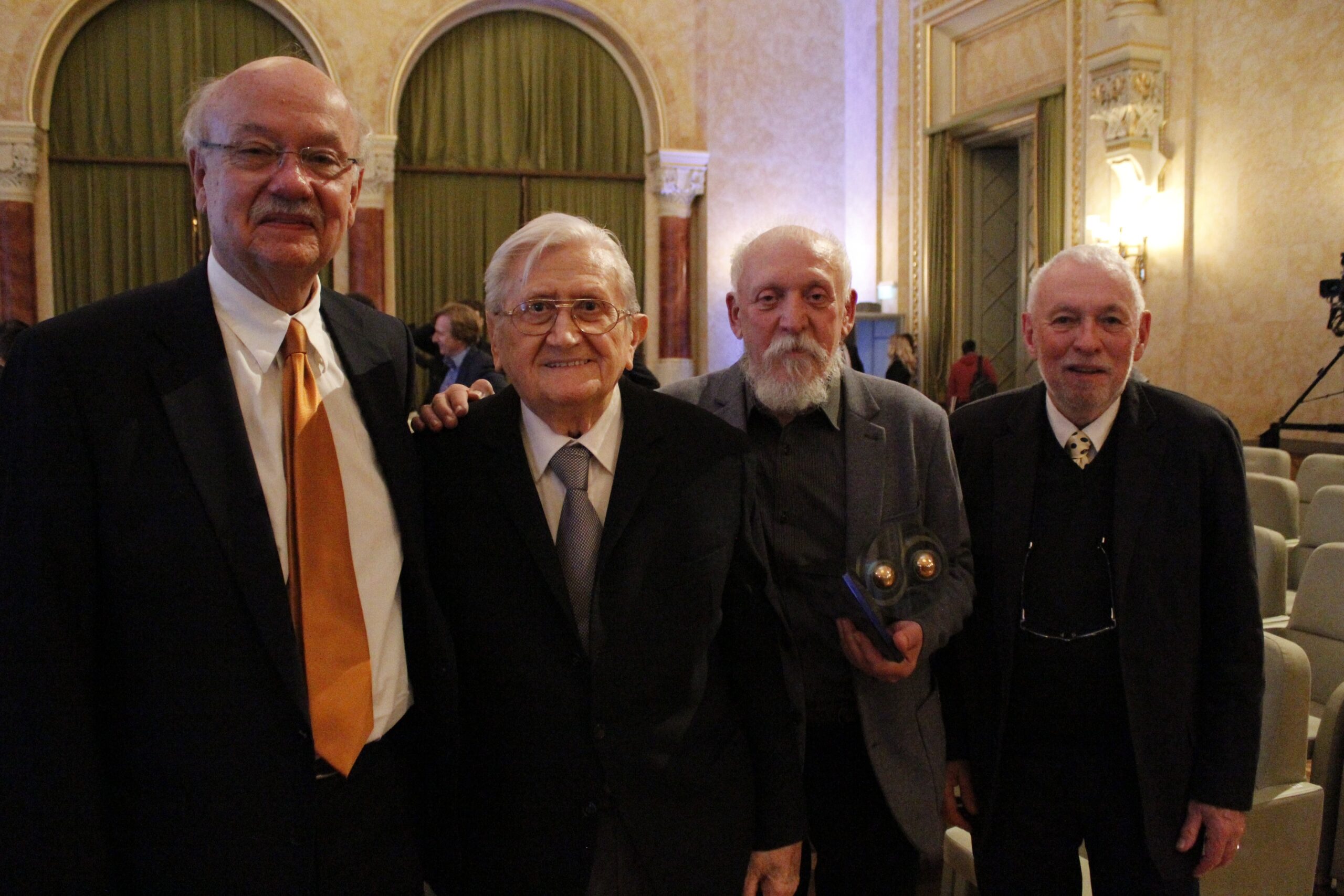
The way in which IMAGO lists “upcoming events” in the upper right hand corner on their website, is something I’ve always found very convenient. Earlier this year I noticed there was to be a cinematographer’s conference and a celebration of the 30th anniversary of the Hungarian Society of cinematographers, the HSC, in Budapest in February.
The information sort of lingered in the back of my mind after that. After all, some of the most memorable films from the second half of the 20th Century were shot by Hungarian cinematographers. But of course lots of things started piling up in front of me during the next few weeks, I had to focus on the immediate matters at hand and the thought of the Hungarian event gradually faded from memory. But then one day out of the blue came the question: “would you like to join the IMAGO delegation visiting Budapest in February?”
…I needed a full three seconds to make my mind up about that one…
And that’s how almost a dozen of us IMAGO representatives found ourselves at the MMA Secretariat, the Hungarian Academy of Arts, in Budapest in the morning of February 6th, for a round of lectures as part of the HSC cinematographer’s conference.
Emil Novak opens up the proceedings welcoming everyone, and particularly the representatives of IMAGO. In

his opening speech, Mr Novak also expresses a wish, not entirely tongue in cheek, that the powers that be would decide to shoot the next James Bond feature in Budapest -“if they do, we’ll be ready for them”, he cheerfully rounds off, handing over to the next speaker.
János Vecsernyés HSC is responsible for the education of cinematographers at the university in Budapest and gives a speech on the conditions of teaching cinematography in Hungary. The University recently applied for -and were granted- funds so that the students can dedicate an entire semester to shooting on 35mm film. Shooting on film, the students are forced to have a preliminary image in their minds of what they want to achieve visually.
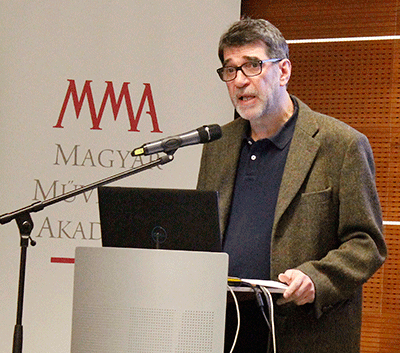
The Hungarian cinematography school began in the late 1940s. It’s well known throughout the world and its Grand Old Man among teachers was nicknamed ”Uncle George”.
By tradition rules are taught in cinematography classes, Mr Vecsernyés explains, such as the necessity of establishing shots at the beginning of a sequence, or the rules of screen direction. But throughout his lecture Mr Vecsernyés stresses the importance of well-educated cinematography students having the knowledge to not only follow the rules, for the sake of clarity, but also to be able to break them for artistic reasons.
There’s a direct connection from Mr Vecsernyés’ lecture to the next speaker, since László Bille points to the excellent level of education of Hungarian film crews as one explanation why International filmmaking in Hungary is booming right now. As an example, director Denis Villeneuve recently shot ”Blade Runner 2049” and ”Dune” (last year) in Hungary.
Mr Bille knows what he’s talking about. He is a very much in demand camera operator working on big budget productions and he can personally vouch for the fact that Hungarian crews are highly skilled.
But the advantages to shooting in Hungary do not end there. Hungary is also financially attractive to international productions, since through a rebate system up to 30 % of the money spent here can be refunded to the production. There are also amazing locations, and Budapest can ”stand in” for Berlin, Paris -even London if you chose your locations carefully.
There are as many as 20 sound stages available in Budapest, the majority of them are sound proofed and climatized, many of them are quite large. Additionally, Hungary being a part of the European Union, bringing crews and equipment in is a breeze. Equipment can be flown in from Munich or London very swiftly. Many of the Hungarian studios also have huge back lots. Korda’s back lot has a big contemporary New York set and at another facility there is also a 19th century New York set.

On the subject of working conditions, though, there is no union in Hungary -which means there’s no one to protect Hungarian crews from horrendous working hours. Foreign producers just smile when they have to pay the fines for overtime on Hungarian crews -it’s peanuts for the production. The pay for the Hungarian crews is very good by local standards and allows them a comfortable life in Hungary, but these salaries are low when compared to U.S. or U.K. salaries.
Big international productions usually fly in their own key creative personel, such as DoPs, set designers, sound crew, etc, but use Hungarian labour for everything ”below the line”. There are world class english speaking gaffers and operators in Hungary, so there really isn’t any need to fly in these people from abroad.
Nigel Walters BSC opens his presentation by confessing that he has been in love with Hungary since his childhood. He was an avid stamp collector and the Hungarians had the biggest, most artistic stamps of any nation. Years later, when he was a young man, the Hungarians beat England spectacularly in football in 1954, and Nigel being Welsh was highly delighted by this.
But the subject for Mr Walters’ speech this morning is Working Conditions, and he feels that the situation in that arena for film and TV workers have deteriorated internationally in the last few years to such a degree that immediate action is now required.
Mr Walters stresses the importance of solidarity among film workers as well as the application of laws and regulations as the way forward here. He also points to Denmark being an Eldorado when it comes to working conditions on film sets. “The Danes have the best working conditions for the general work force already in place”, Mr Walters asserts, “so perhaps small wonder that they have also managed to get the film productions running smoothly and in an orderly fashion. Denmark is a shining beacon and a role model for how to run film productions from a working conditions perspective. Anti social hours are remunerated by an additional 50% extra for the first 2 hours, and a 100% for additional hours. They also have right to royalties for their intellectual rights.
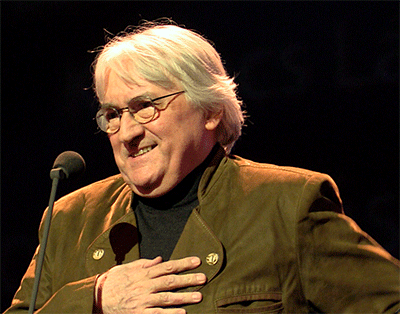 |
| The President of the HSC, Academy Award-nominated Hungarian cinematographer and film director Lajos Koltai ASC HSC, opens the Award ceremony |
The DFF, the Danish Cinematographers Society, was established in the 1950s, but the decisive moment was when the DFF joined the combined forces of the other film workers including the directors in the film workers association, the FAF”.
By comparison working conditions in the U.K. are not characterized by solidarity. “It’s every man for himself with occasional sniper fire thrown in for good measure”, Mr Walters offers. However, he feels working conditions are slowly improving in the U.K., particularly at the high end of productions in TV and features, as producers realize that working long hours is inefficient and counter productive. The discussion on payments in general for U.K. film crews is under control, but payment for travel time to production, preparation and wrap are particularly difficult subjects.
Mr Walters suggests, as an example of a sensible state of affairs on U.K. productions, the fact that in England the grips are 100% solid union members. Any infringement on agreements are reported secretly to the union who deal with the case with the production.
The most dire aspect of working conditions is of course that personel occasionally are killed in accidents on set. “On a TV series in Ghana over three years ago, Mark Milsome, one of our most respected U.K. camera operators was killed on a night shoot”, Mr Walters declares. He continues to also describe a tragic accident on an American production where crew member Sarah Jones was tragically killed due to production deliberately ignoring safety measures. ”Those responsible were sent to jail which in my opinion is the only sensible reaction to such gross misconduct on behalf of the production company”.
Sadly, Spain has also experienced deadly accidents on film sets lately. ”One of Spains most respected stunt drivers was killed in an accident involving a Russian arm on a racing circuit in november 2019. The AEC are frustrated because of the lack of information regarding the manner in which the stunt driver was killed and five others injured. Unless you know the causes for these accidents nothing can be done to ensure the safety of film workers in future productions”.
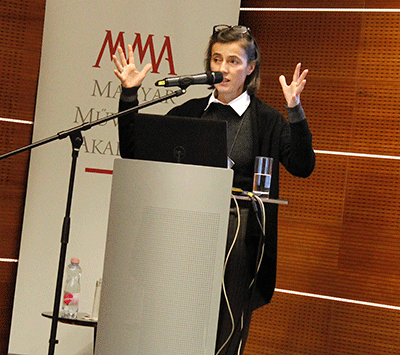 |
| Mercedes Escherer from InterfaceFilm has been lobbying for labour rights for freelance workers in Europe for many years |
Kurt Brazda AAC is the chairman of the IMAGO Working Conditions Committee, and one of the focal points of his speech is the dilemma concerning the opportunities and threats inherent in digital technology.
”Digitalization has transformed the world like a tidal wave and will continue to transform it even more than we can imagine. This development could lead to digital slavery if we don’t watch out”, Mr Brazda warns us. “European law stipulates that there must be an 11 hour rest period from work each day, but 12-14 hour working hours are not unusual in the Film and TV industry! Older crew members cannot endure such a strain and fall out of the race early on and you get a sort of “age racism” on film sets. It almost becomes impossible for younger crew members to start a family and the constant tiredness causes serious failures and accidents on film sets. Making matters worse, many workers in the Film and TV industry no longer dare question their working environment.
The IMAGO working conditions committee picked up a request from our American colleagues on this matter some time ago. In their “12 on-12 off” campaign they demand that a working day should not exceed 12 hours. We in the IMAGO Working Conditions Committee say “10 on 14 off”, which corresponds to European conventions and the EU Working Time Directive, which only allows 50 hours a week.
There is enormous capital and great profits involved in the international audiovisual industry, so to claim that these working hours are a necessary evil in order to economize production budgets simply isn’t true. The international audiovisual industry has an annual turnover of 150 Billion Euros! The need for audiovisual content is increasing rapidly, therefore our work is crucial to achieve these huge turnovers.
Filmmakers –and especially cinematographers- must not give in to the brutal economic pressure but stand up for their rights together. An international association such as IMAGO has a great opportunity to be the right platform for this task, thereby uniting thousands of cinematographers!
The film industry is a blue print for the future working conditions of the entire work force! European film workers do not understand the importance of solidarity among the work force, they are unaware of their rights. ”Divide and Conquer” was the maxim of the old Roman Emperors -it is up to us now to break this division! We need effective unions, ensuring us the collective bargaining power which the single film worker can never muster. Solidarity is the magic word here!
Dear friends, we are much stronger than we think we are, because if we really act in solidarity, it is not a dream”, Mr Brazda concludes.
The last speaker at the conference is Mercedes Escherer. Born in Transylvania, she is half Hungarian and an actress by profession.
Mrs Escherer created INTERFACE FILM in Austria a few years back and with the help of this organization IMAGO managed to twice submit to the European Parliament a request, aiming to improve living and working conditions in the European Film and TV industry.
Mrs Escherer suggests that we as audiovisual artists should be more proud, since we are a financially important part of the European economy, and as European artists we are also a role model for artists all over the world. There is a lack of communication between the artists producing the intellectual property and the policymakers who establish the laws and regulations which rule the working conditions of these artists.
Mrs Escherer finishes her lecture by asking us to convey her love and regards to everyone at tomorrow’s award ceremony, since she had just received a phone call requiring her to return to Vienna already Thursday evening.
Thus ended the HSC Cinematographers’ conference. We had a few hours time off before joining forces once more that evening at the Menza restaurant for a truly wonderful
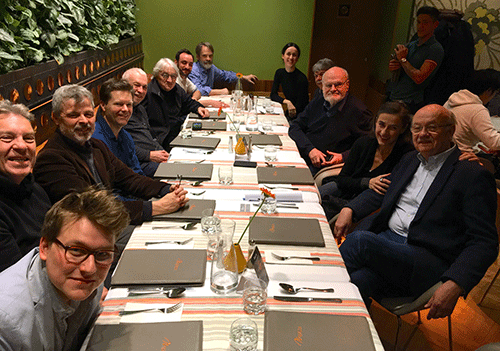 |
| A great evening at the Menza restaurant. The young man in the lower left corner is our wonderful guide David Mihályi, who took such good care of us during our stay in Budapest. Directly behind David, in brown jacket, is delegate Roger Simonsz BSC, an invaluable member of the IMAGO team. |
gastronomic experience. The entré courses here were the size of an ordinary main course at your average neighborhood restaurant. All this laced with wine, beer -and the traditional Hungarian schnaps: Palinka! At first impression, this semi-lethal stuff appears to be something akin to industrial-strength paint remover… but strangely, it tasted better and better as the evening continued!
Let it be said once and for all, that our stay as guests of the HSC was very comfortably planned, allowing us almost all of Friday to ourselves as the HSC Awards Ceremony does not begin until 6 pm. Myself, never having visited Hungary before, was eager for some taking in of the local sights. Fortunately, there were one or two others in our party who shared my sentiments, and Kurt Brazda AAC, Supreme Commander of the Austrian delegation, fortunately knows his way around Budapest as if it were his own ”Hintertasche” and was kind enough to take us with him on a little sightseeing trip.
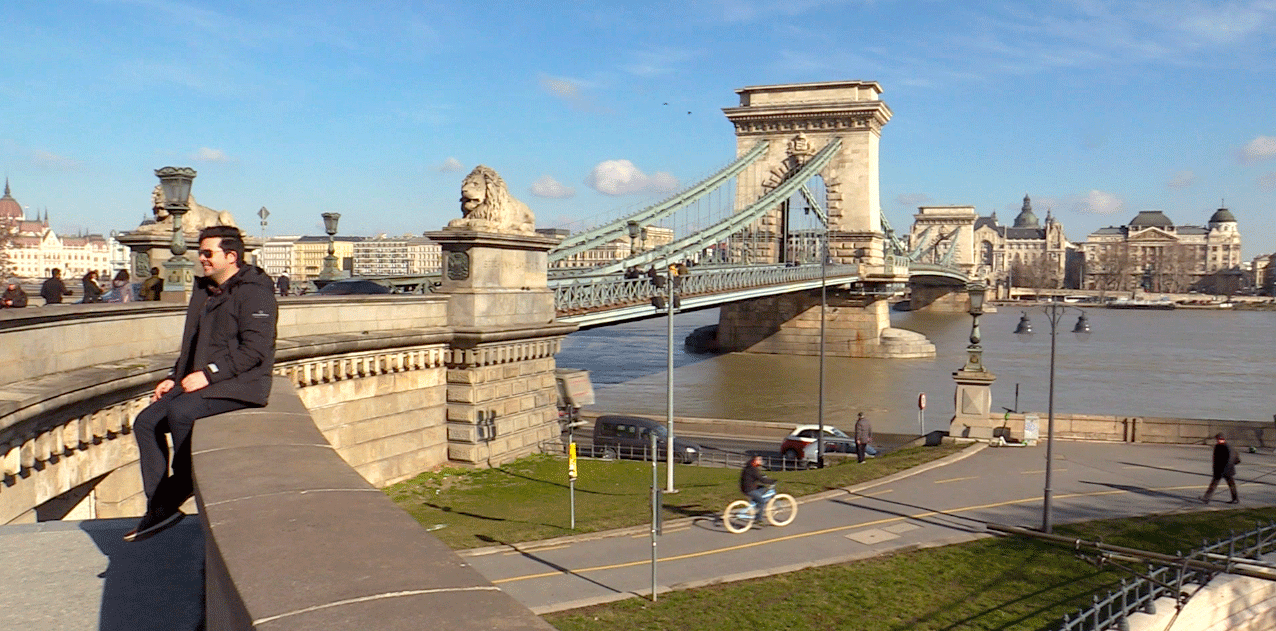 |
| The Szechenyi Lanchíd bridge across the Danube |
The magnificent city is bathing in sunshine and those of us lucky enough to be in on this little excursion are treated to a wonderful tour around the Hungarian capital. Kurt Brazda is a scholar of encyclopedic proportions when it comes to cultural history, and he is the ideal guide.
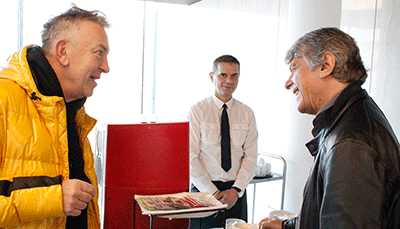 |
| Predrag Bambic shares a joke with Rolf Coulanges |
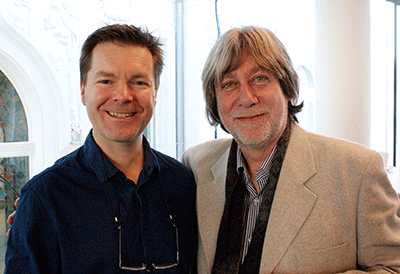 |
| Old friends Alex Lindén and László Bille |
We begin by passing the Szechenyi Lanchíd bridge, named after the Duke who had it built. Lanchíd means ”chain bridge”, we are informed, and this magnificent bridge was constructed in the 1840s. Crossing the bridge one can’t help noticing that ”Die Schöne Blaue Donau” unfortunately isn’t particularly blue these days. Some purification work will surely have to be done in the near future… but that’s a minor point on a day like this.
All the plains on both banks of the Danube offer extremely fertile farmland, so there’s little wonder people have settled down here since ancient times. Budapest were originally two cities, Buda and Pest, situated on both sides of the Danube. After the Turkish threat was neutralized, the great cities along the Danube: Vienna, Belgrade and Budapest became very beautiful. As the military fortifications were no longer deemed necessary, a lot of effort was put into building castles and the general beautification of these cities.
We continue up the mountain to the old city of Buda, with its spectacular architecture. In the 1870s the two cities on both banks of the Danube merged into one, and the world-class view we are offered from here over the modern city of Budapest reveals the fruition of that amalgamation. There is no shortage of breathtaking panoramic vistas here. In fact it appears quite possible Budapest is the real reason why Cinemascope was originally invented!
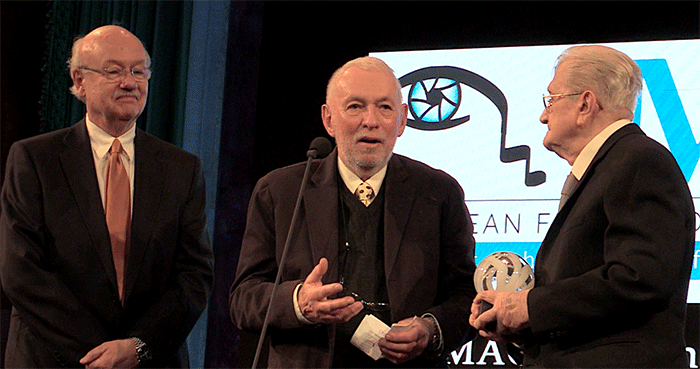 |
| IMAGO President Paul René Roestad FNF and former IMAGO President Nigel Walters BSC present the IMAGO Award to former IMAGO President Tibor Vagyóczky. |
So, finally, at 6 pm it becomes time for the HSC Awards Ceremony, and we all gather at The Vigado Concert Hall. If perhaps a shade to modern here and there, in terms of sheer splendor and opulence the Vigado could easily have stood in for a Tsarist Russian palace during the production of Sergei Bondarchuck’s legendary ”War and Peace” (1967). This place has to be seen to be believed, it’s a beautiful classical building at the river Danube bank, with a spectacular view of Budapest’s unique UNESCO World Heritage sites.
Built in 1859 and badly damaged in World War II, the Vigado underwent a more than 30 year long painstaking reconstruction, and today stands as a world class concert venue. The Vigado Concert Hall is the second largest, but certainly the most beautiful, concert hall in Budapest.
Walking up the grand staircase towards the actual concert hall, one almost feels one is attending the Academy Awards in Hollywood, because the HSC have put on quite a show!
But one thing at a time, and before the Awards Ceremony first stop on the program is mingling in the foyer outside the concert hall, where the champagne is being served by a small army of waiters running nonstop with trays of glasses, filled from an ostensibly inexhaustible supply of champagne. Then we’re seated in the auditorium, and the Awards Ceremony begins. Formally, the name of the event is the László Kovács and Vilmos Zsigmond Cinematographer Competition, and it is held this year for the third time. The event is a collaboration between the HSC and the School of Hungarian Cinematographers.
Academy Award-noimated Hungarian cinematographer and film director Lajos Koltai, ASC, HSC opens the proceedings. Mr Koltai is perhaps best known for his work with legendary Hungarian director István Szabó and Italian filmmaker Giuseppe Tornatore.
The beautiful HSC Lifetime Achievement Awards are then handed over to Nyika Jancsó HSC and András Szalai HSC, respectively, before the time comes to what is of course a
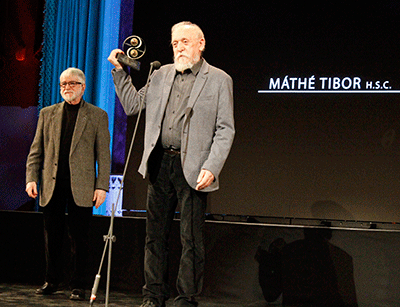 |
| Tibor Máthé with his well deserved Lifetime Award |
special highlight of the evening for us in the IMAGO delegation. Tibor Vagyóczky, who was president of IMAGO from 2001-2003, will be the recipient of the IMAGO Award. Mr Vagyóczky will also be selected as the first Hungarian honorary member of IMAGO.
IMAGO President Paul René Roestad FNF and former IMAGO President Nigel Walters BSC enter the stage and each give a short speech.
An amusing moment, much to the mirth of the audience as well as everyone on stage, occurs when Mr Roestad at the beginning of his speech is baffled by the sudden interruption of the fastidious Hungarian interpreter! The show stops for a split second as everyone laughs heartily, and after that the proceedings move on seamlessly once we all get used to the formality of pauses for interpretation.
Messieurs Roestad and Walters then hand over the award to mr Vagyóczky, who is noticeably moved and gives a short acceptance speech.
It must be admitted that our interpreter, by the way, put in some almost superhuman work during our stay in Budapest! How anyone can translate that quickly between two so dissimilar languages like Hungarian and English is beyond me.
As the awards ceremony continues, Tibor Máthé HSC receives a lifetime award. László Bille is also honoured. The winners in four categories – feature film, television, documentary
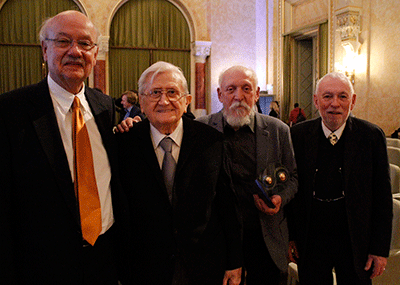 |
| Paul René Roestad, Tibor Vagyóczky, Tibor Máthé and Nigel Walters |
and short film- are also given their prizes.
Throughout the ceremony I am struck by the dignity, composure and modesty which the recipients -without exception- all display. Everyone accepts their awards with gratitude and -this I found particularly exemplary- remembered to thank their teachers at the School of Hungarian Cinematographers as well, for teaching them the craft in the first place.
When I mention being impressed by this to Nigel Walters, he informs me that when Vilmos Zsigmond ASC HSC in 1977 picked up his Oscar for Steven Spielberg’s ”Close Encounters of the Third Kind”, he thanked ”Uncle George”, The Grand Old Man of Hungarian cinematographic education, who had initially taught him the craft.
Now that’s a class act.
Lars Pettersson FSF





























